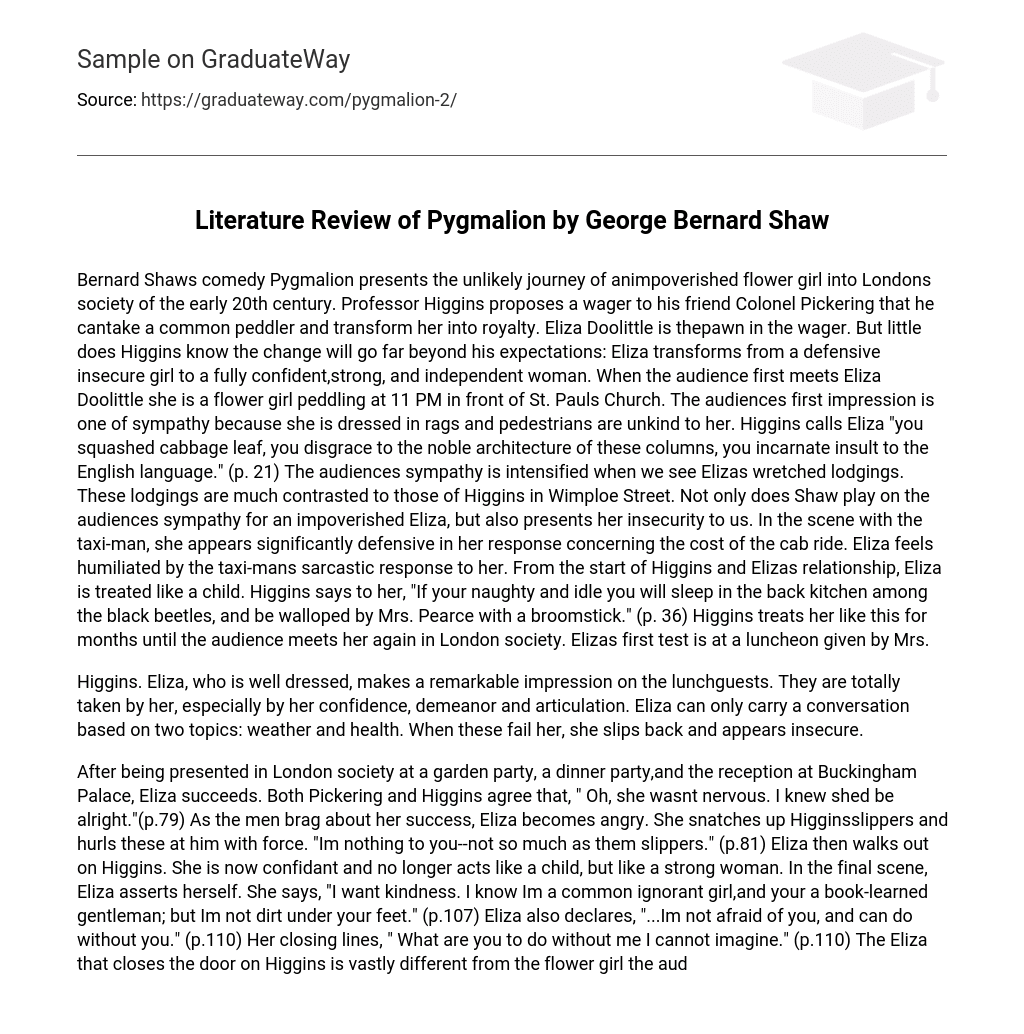Bernard Shaws comedy Pygmalion presents the unlikely journey of animpoverished flower girl into Londons society of the early 20th century. Professor Higgins proposes a wager to his friend Colonel Pickering that he cantake a common peddler and transform her into royalty. Eliza Doolittle is thepawn in the wager. But little does Higgins know the change will go far beyond his expectations: Eliza transforms from a defensive insecure girl to a fully confident,strong, and independent woman. When the audience first meets Eliza Doolittle she is a flower girl peddling at 11 PM in front of St. Pauls Church. The audiences first impression is one of sympathy because she is dressed in rags and pedestrians are unkind to her. Higgins calls Eliza “you squashed cabbage leaf, you disgrace to the noble architecture of these columns, you incarnate insult to the English language.” (p. 21) The audiences sympathy is intensified when we see Elizas wretched lodgings. These lodgings are much contrasted to those of Higgins in Wimploe Street. Not only does Shaw play on the audiences sympathy for an impoverished Eliza, but also presents her insecurity to us. In the scene with the taxi-man, she appears significantly defensive in her response concerning the cost of the cab ride. Eliza feels humiliated by the taxi-mans sarcastic response to her. From the start of Higgins and Elizas relationship, Eliza is treated like a child. Higgins says to her, “If your naughty and idle you will sleep in the back kitchen among the black beetles, and be walloped by Mrs. Pearce with a broomstick.” (p. 36) Higgins treats her like this for months until the audience meets her again in London society. Elizas first test is at a luncheon given by Mrs.
Higgins. Eliza, who is well dressed, makes a remarkable impression on the lunchguests. They are totally taken by her, especially by her confidence, demeanor and articulation. Eliza can only carry a conversation based on two topics: weather and health. When these fail her, she slips back and appears insecure.
After being presented in London society at a garden party, a dinner party,and the reception at Buckingham Palace, Eliza succeeds. Both Pickering and Higgins agree that, ” Oh, she wasnt nervous. I knew shed be alright.”(p.79) As the men brag about her success, Eliza becomes angry. She snatches up Higginsslippers and hurls these at him with force. “Im nothing to you–not so much as them slippers.” (p.81) Eliza then walks out on Higgins. She is now confidant and no longer acts like a child, but like a strong woman. In the final scene, Eliza asserts herself. She says, “I want kindness. I know Im a common ignorant girl,and your a book-learned gentleman; but Im not dirt under your feet.” (p.107) Eliza also declares, “…Im not afraid of you, and can do without you.” (p.110) Her closing lines, ” What are you to do without me I cannot imagine.” (p.110) The Eliza that closes the door on Higgins is vastly different from the flower girl the audience first meets at the beginning of the play. Her decision not to marry Higgins reveals a mature and independent Eliza, a person free to choose. Elizas transformation occurs over the six months of her living with Higgins. Their relationship can be described as father/daughter. Her evolution into a young woman is evident in her rebellion like a daughter rebels against her father. It is only through this that Eliza can become an assertive woman. Shaws play Pygmalion demonstrates a girls rite of passage.





